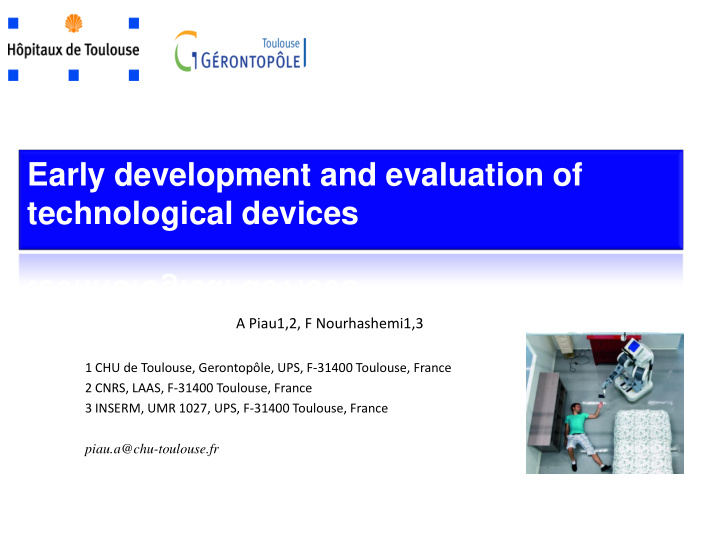



Early development and evaluation of technological devices A Piau1,2, F Nourhashemi1,3 1 CHU de Toulouse, Gerontopôle, UPS, F-31400 Toulouse, France 2 CNRS, LAAS, F-31400 Toulouse, France 3 INSERM, UMR 1027, UPS, F-31400 Toulouse, France piau.a@chu-toulouse.fr
Background Commercial market of aging care remains poorly developed since introduction of low-technology devices decades ago 1. 1. A lack of early multidimensional reflexion during technology development (leading to irrelevant tools) 2. 2. A lack of evaluation (e.g. Cohrane « Smart Homes ») This deficiency is due to the confrontation of two worlds: - technology = not yet well versed in the field of healthy aging intervention = techno-push strategy - medical = mainly uses the linear pharmaceutical drug development model
Background SILVER ECONOMY ???? We need to develop more relevant devices = « techno-pull strategy» Many methods are proposed for multidimensional evaluation of health technologies, they do not address the early development and evaluation processes
Where to start? Not with the technologies but from what we need !! Connected Medical Feed-back software Socio-cultural software Software device software -Performance indicators Motivationnal coaching -Transport -Failure alert software presentation -Culture -Maintenance reminders -Nutrition -Shopping, home delivery -Physic exercice Social network -Therapeutic education -Family and relative -Social caregivers coordination MD computer = Dash-board Home computer = Touch-pad -Frailty indicators trends - Patient interface -Medical relevant events - Data collection Internet secured -Intervention adherence transmission to database - Pre-treatment -Alerts Connected Medical Hardware Intervention devices Monitoring devices Medication devices device -Wii -Gait speed -Pill-box -Failure alert - Weight… -Fitness devices -Maintenance reminders Communication device -Ergonomic upgrade cell-phone
Method and results Our goal was to build a one- page “pocket work plan” for health technology development for people who want to develop a health device but do not exactly know how to do (e.g. young start-uppers). It could be used by all kind of stakeholder, whatever their culture (technical, human sciences, etc.) and their organization (e.g. academic, SME’s). - First we have described the different dimensions of evaluation to identify essential partners to built an efficient consortium - Secondly we have proposed different critical phases for the technological development and evaluation - Then we Have proposed a framework to describe relationships between development phases and evaluation dimensions this is the basis of a concrete working plan (e.g. work-packages )
Results Characteristics of health technologies as compared with drug development: - Evaluation of technology is multidimensional and multidisciplinary; - Results are more dependent on the implementation context of the technology; - Technology evaluation is non-linear, more iterative (feed feedback loops); - Quantitative research strategies need to be combined with qualitative strategies; - Less time is available for technology evaluation because of the quickly changing market, etc.
Results A basis to: (i) identify the relevant partners for a consortium, (ii) built a first draft of a work plan, (iii) and provide a first idea of each partner tasks.
Results This multi-phased design, from lab test to field tests, allow to perform iterative modifications of thte devices hanks to end user’s recommendations. e.g. young volunteers in a lab (technical performances of the first prototype) e.g. healthy old people in a living lab (acceptability of the second prototype) e.g. frail individuals in a clinical comparative study at home (acceptability in real-life conditions)
Discussion and conclusion Our method is successfully tested through several completed or ongoing 3 projects that have been funded by health authorities and ratified by clinical research ethical committee. No matter the type of technology, its development stage, and the clinical application, our method was easily adaptable, flexible and scalable. Our proposed “pocket tool” is a valuable support, for example during a first meeting with a technical partner (not yet versed in health technology development and assessment), to evaluate the feasibility of a project and is also the basis of a first concrete working plan (e.g. work-packages). 3.Piau A, Charlon E, Campo E, Vellas B, Nourhashemi F. A Smart Insole to Promote Healthy Aging for Frail Elderly Individuals: Specifications, Design, and Preliminary Results. JMIR Rehabilitation and Assistive Technologies 2015;2(1): e5 p.1; doi:10.2196/rehab.4084
Recommend
More recommend